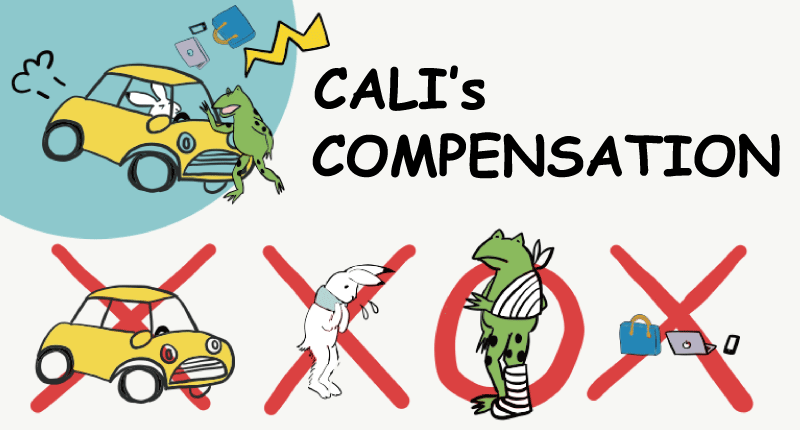In Japan, purchasing primary insurance is legally mandatory for every vehicle owner. The insurance name is Compulsory Automobile Liability Insurance ("Jibaiseki" in Japanese). Jibaiseki is for protecting traffic accident victims. Jibaiseki's coverage is not wide and sufficient, but it compensates for bodily damages of almost all the victims. In this article, we take a closer look at what it is and how it works.
Why is it legally mandatory?
CALI (Jibaiseki) is legally mandatory to carry for all of the owners of major vehicles. (Supported by the Japanese Law, Act on Securing Compensation for Automobile Accidents) With CALI, vehicle owners fulfill the minimum responsibility to compensate for traffic accident victims. If you don’t carry it when driving, you will be imposed a penalty of one year of imprisonment or fine of under ¥500,000.
Jibaiseki's price
CALI's price in Japan (Unit: JPY)
| Kinds of vehicle | Contract period (month) | |||||
| 37 | 36 | 25 | 24 | 13 | 12 | |
| Regular passenger vehicle | 36,780 | 35,950 | 26,680 | 25,830 | 16,380 | 15,520 |
| Small motor truck | - | - | 30,460 | 29,470 | 18,360 | 17,350 |
| "Kei" passenger vehicle which is for "Shaken" | 35,610 | 34,820 | 25,880 | 25,070 | 15,960 | 15,130 |
| Regular truck of which maximum carring capacity is over 2t | - | - | 53,890 | 51,990 | 30,660 | 28,720 |
| Regular truck of which maximum carring capacity is under 2t | - | - | 44,100 | 42,580 | 25,520 | 23,970 |
| Motorcycle with over 250cc | 14,950 | 14,690 | 11,780 | 11,520 | 8,560 | 8,290 |
| Motorcycle with 125-250cc | - | 15,720 | - | 12,220 | - | 8,650 |
| Motorized bycycle with under 125cc | - | 2,340 | - | 9,950 | - | 7,500 |
*The price is slightly different in Okinawa pref.
Also see where to buy Jibaseki.
Jibaiseki's coverage

Jibaiseki (CALI) was established for the relief of traffic accident victims. It only compensates for injured or dead victims. It doesn't cover the at-fault party's physical damages. Besides it never covers property damages.
The following table shows two occasions CALI is paid. It also shows the upper limit of its payout.
| Case | The upper limit of CALI's payout |
| (1) A victim got injured. | Maximum JPY1,200,000 |
| (2) A victim was dead. | Maximum JPY30,000,000 |
| (3) A victim was left with residual disability. | Maximum JPY40,000,000 |
Note these are not the amount that will be paid to a victim for sure, but the amount bases on your actual damages and losses. For more detail, see the articles below.
- Cost breakdown of CALI's payout for an injured victim
- Cost breakdown of CALI's payout for a dead victim
CALI doesn't only compensate for injured or dead victims, but also compensates for victims left with residual disability in a traffic accident. The upper limit of payment for residual disability is JPY40,000,000.
The insurance money for residual disability bases on CALI's original payout table showing the grade of residual disability and each insurance money. If CALI admits your disability falls into 3rd grade, the total amount of ¥22,190,000 will be paid to you for sure. See Tables of CALI's compensation for residual disability.
Since CALI's coverage is minimum, it's not sufficient for covering all the losses of victims in most cases. For example, if you're hospitalized due to the injury for a month, CALI's payout of JPY1,200,000 is sometimes not sufficient even for the medical expenses. So more than 74% of drivers additionally purchase voluntary insurance to fulfill the responsibility to compensate for the victim's damages.
For hit-and-run accident victims or victims hit by a non-insured car
CALI is mandatory for every vehicle owner, however, what if you are hit by a car that doesn't carry CALI? For relieving such victims, the Japanese government has a special plan called "Government Compensation Plan". It's for victims of a hit-and-run accident or victims hit by a non-insured car. It offers the same amount of compensation as CALI. You can apply for the payout from the plan via third party organizations like insurance companies, just like applying for the payout of CALI.